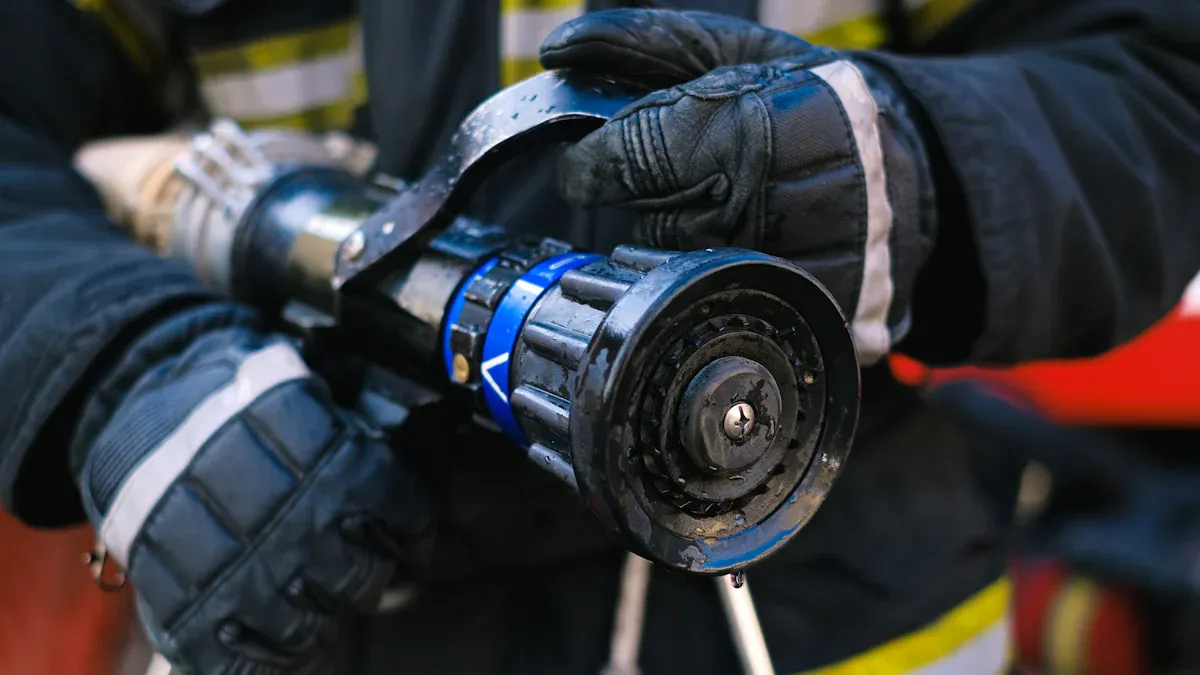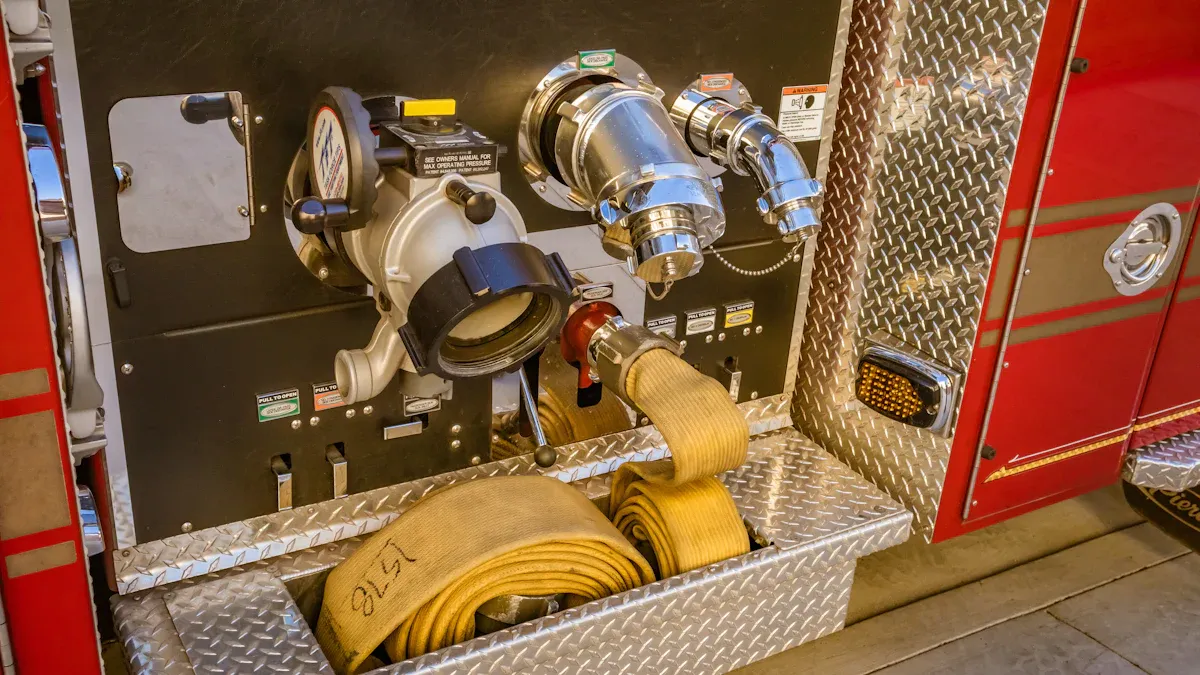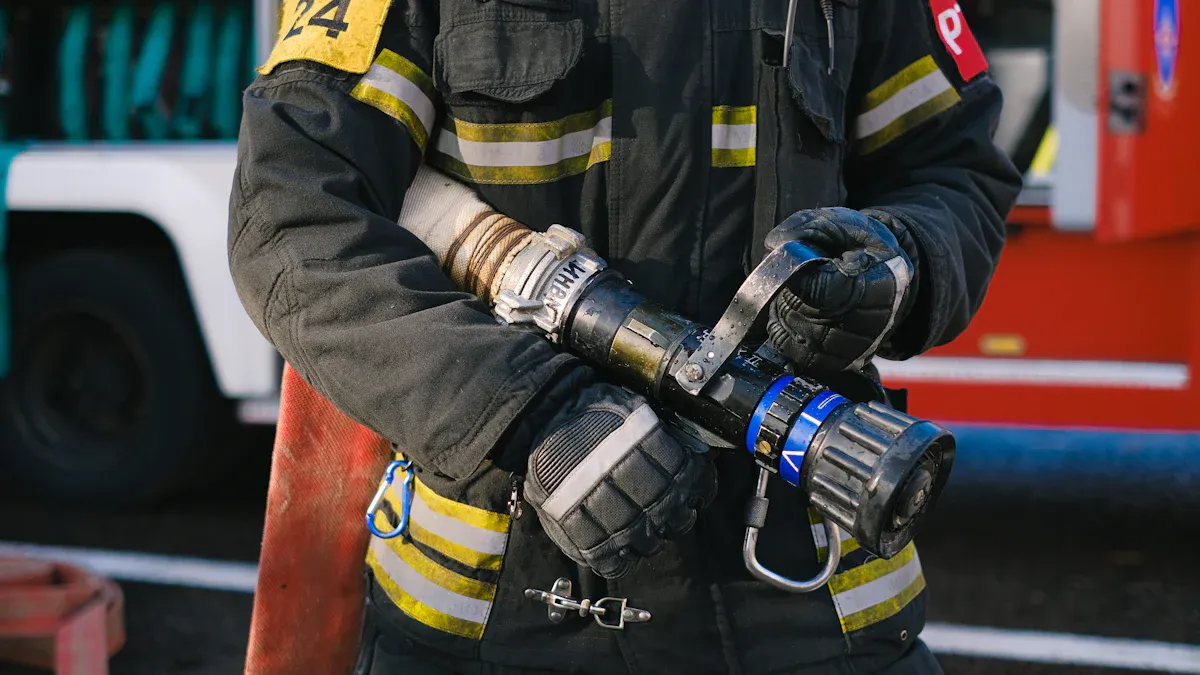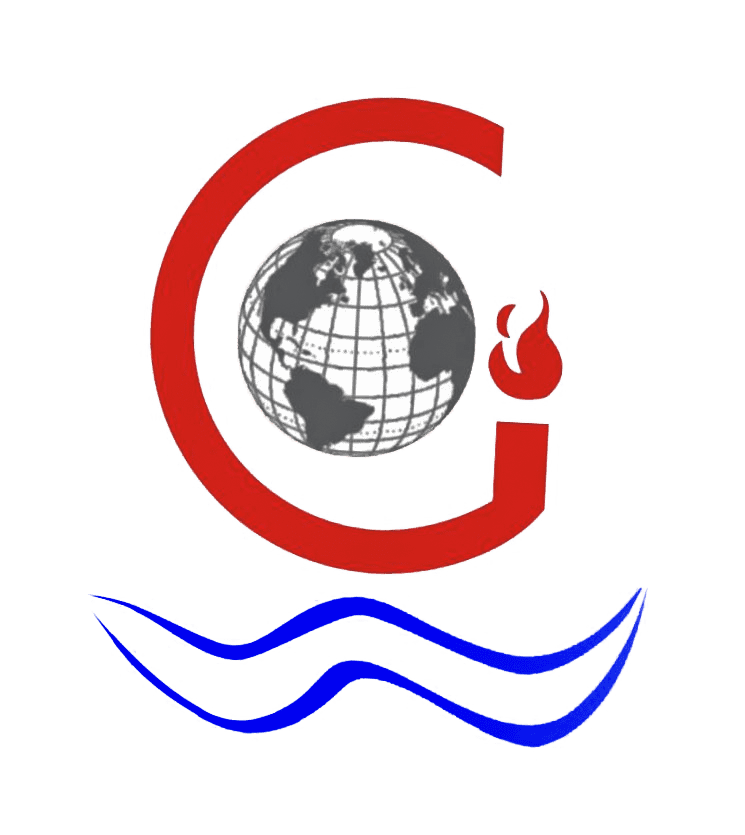
Industrial fire safety systems rely significantly on the performance of nozzles to ensure maximum efficiency. At Yuyao World Fire Fighting Equipment Factory, we provide a range of nozzles designed for precision and adaptability. Our high-pressure nozzles ensure effective water delivery even under extreme conditions, while the adjustable flow rate nozzles allow for tailored water output to meet specific needs. Multi-functional nozzles offer versatility for various fire scenarios, and foam nozzles are ideal for specialized fire suppression applications. These advanced nozzle designs are essential for rapid and dependable fire safety solutions.
Key Takeaways
- Picking the right nozzles and couplings is very important. Think about your workplace needs to make them work best.
- Using nozzles and couplings together helps water flow better. This teamwork saves water and speeds up emergency responses.
- Training and checking fire safety systems often is necessary. Regular checks keep them working well and meeting safety rules.
Understanding the Role of Nozzles and Couplings

Nozzles: Types and Their Importance in Fire Safety
Nozzles play a pivotal role in industrial fire safety by controlling water flow and ensuring precise delivery to the fire source. Different nozzle types cater to various applications, each offering unique advantages. Brass nozzles, widely used in firefighting, excel in environments with moderate chemical exposure and transfer heat seven times faster than stainless steel. They are also cost-effective, typically priced 20–30% lower than stainless steel options. On the other hand, stainless steel nozzles are preferred for high-pressure applications, such as chemical processing and offshore platforms. Their superior tensile strength and corrosion resistance make them ideal for challenging environments.
| Property | Brass | Stainless Steel |
|---|---|---|
| Density | 8.49 g/cm³ | 7.9–8.0 g/cm³ |
| Tensile Strength | 338–469 MPa | 621 MPa |
| Corrosion Resistance | Moderate | High |
| Melting Point | 927°C (1700°F) | 1510°C (2750°F) |
Selecting the right nozzle ensures optimal fire suppression performance, tailored to the specific needs of industrial systems.
Couplings: Ensuring Secure and Reliable Connections
Couplings are essential for maintaining secure connections between hoses and nozzles, ensuring uninterrupted water flow during fire emergencies. Verified standards, such as ANSI/UL 448 and ANSI/UL 218, validate the reliability of fire safety couplings. These standards cover aspects like centrifugal pumps, flexible couplings, and fire pump controllers, ensuring compatibility and durability under high-pressure conditions. Proper coupling design minimizes leaks and enhances system efficiency, making them indispensable for industrial fire safety systems.
| Standard | Description |
|---|---|
| ANSI/UL 448 | Centrifugal Stationary Pumps for Fire-Protection Service |
| ANSI/UL 218 | Fire Pump Controllers |
| ANSI/UL 508 | Industrial Control Equipment |
How Nozzles and Couplings Work Together in Fire Suppression
Nozzles and couplings function as a cohesive unit to enhance fire suppression performance. Proper placement of the coupling next to the nozzle reduces friction and facilitates smooth hose advancement. This setup prevents issues like “hose spaghetti,” which can hinder maneuverability and water application. Together, they ensure efficient hoseline deployment, enabling firefighters to respond rapidly and effectively to emergencies. Their integration maximizes water flow and coverage, ensuring fires are suppressed quickly and reliably.
Benefits of Integrating Nozzles and Couplings
Enhanced Water Flow and Fire Coverage
Integrated nozzle and coupling systems optimize water flow and improve fire coverage in industrial settings. By ensuring seamless connections between hoses and nozzles, these systems reduce friction and enhance water delivery to the fire source. Advanced nozzle designs, such as adjustable flow rate and multi-functional nozzles, allow precise targeting of flames, minimizing water wastage and maximizing suppression efficiency.
Studies have demonstrated that nozzle configurations significantly impact particle collection efficiency, which is critical for evaluating system performance. Efficiency curves for various setups show comparable sharpness of cutoff to established systems, validating their effectiveness in fire suppression. Additionally, the use of two impinging jets for inertial particle separation has proven practical for controlling particulate emissions, further showcasing the versatility of integrated systems.
These innovations ensure that industrial fire safety systems can adapt to diverse fire scenarios, providing reliable coverage and reducing the risk of fire spread.
Faster Emergency Response and Reduced Downtime
Integrated systems contribute to faster emergency response times, enabling industrial facilities to contain fires more effectively. Smart couplings equipped with sensors facilitate real-time monitoring, allowing fire safety teams to detect and address issues promptly. Predictive maintenance enabled by these sensors minimizes manual intervention, ensuring uninterrupted system operation during emergencies.
| Statistic | Impact |
|---|---|
| IoT integration can reduce emergency response times by up to 35% | Higher survival rates, quicker containment of fires, faster police presence |
| 80% of EMS agencies report improved dispatch accuracy with IoT-enabled systems | Ensures correct unit dispatch based on real-time data |
These advancements not only improve response times but also reduce downtime caused by system failures. Facilities equipped with integrated nozzle and coupling systems experience fewer disruptions, maintaining operational continuity even in high-pressure situations.
Improved System Reliability and Longevity
Proper integration of nozzles and couplings enhances the reliability and lifespan of fire safety systems. Regular maintenance, performed by trained professionals, ensures that all components function optimally. Accurate record-keeping of maintenance activities prevents the accumulation of debris, which can compromise equipment precision.
- Timely maintenance extends the longevity of fire alarm systems.
- Calibration checks and sensor recalibrations maintain accuracy over time, ensuring compliance with fire safety standards.
- Proactive maintenance prevents false alarms and ensures sustained system performance.
These practices build trust in fire safety protocols and contribute to the durability of integrated systems. Facilities that prioritize maintenance and upgrades benefit from extended system lifespans, reducing long-term costs and enhancing overall safety.
Best Practices for Nozzle and Coupling Integration

Selecting the Right Nozzles and Couplings for Industrial Systems
Choosing the appropriate nozzles and couplings is vital for ensuring the efficiency and reliability of industrial fire safety systems. Each industrial environment presents unique challenges, requiring components tailored to specific conditions. For example, facilities handling flammable chemicals may benefit from stainless steel nozzles due to their corrosion resistance and durability under high pressure. Conversely, brass nozzles may suit environments with moderate chemical exposure, offering cost-effective solutions without compromising performance.
Couplings must also align with the system’s operational demands. Compatibility with hoses and nozzles ensures secure connections, minimizing the risk of leaks or disconnections during emergencies. Standards such as ANSI/UL 448 and ANSI/UL 218 provide guidelines for selecting couplings that meet safety and performance requirements. By adhering to these standards, industrial facilities can enhance the overall reliability of their fire suppression systems.
Installation Techniques for Seamless Integration
Proper installation of nozzles and couplings is critical for achieving seamless integration and optimal system performance. Fire safety professionals should follow established guidelines to ensure effective installation. Key considerations include:
- Identifying areas where fire safety components are most needed.
- Ensuring compatibility between materials and construction elements.
- Adhering to local, state, and national fire safety codes.
- Providing accessibility for routine maintenance and inspections.
- Integrating fire safety measures with other building systems, such as HVAC, plumbing, and electrical systems.
Environmental factors, such as temperature fluctuations and humidity, can impact the performance of fire safety components. High-quality installation techniques account for these variables, ensuring long-term reliability. Additionally, ongoing maintenance and inspections play a crucial role in preserving the integrity of the system.
Case Studies: Successful Implementations in Industrial Fire Safety
Real-world examples highlight the effectiveness of integrating nozzles and couplings in industrial fire safety systems. One notable case involved a chemical processing plant that upgraded its fire suppression system with stainless steel nozzles and smart couplings. The new system significantly improved water flow and reduced response times during emergencies.
Another example comes from a manufacturing facility that implemented adjustable flow rate nozzles and ANSI-compliant couplings. This integration allowed the facility to tailor water output to specific fire scenarios, minimizing water wastage and enhancing suppression efficiency. Regular maintenance and adherence to installation guidelines ensured the system’s reliability over time.
These case studies demonstrate the importance of selecting the right components, following proper installation techniques, and maintaining systems to achieve maximum efficiency in industrial fire safety.
Training and Maintenance for Long-Term Efficiency
Regular Training for Fire Safety Personnel
Comprehensive training programs ensure fire safety personnel are prepared to handle emergencies effectively. Training components include fire evacuation plans, fire drills, and compliance with OSHA regulations. These elements equip employees with the knowledge and skills needed to respond promptly during fire incidents.
| Training Component | Description |
|---|---|
| Fire Evacuation Plan | Develops a detailed strategy to guide employees during emergencies. |
| Fire Drills | Practices evacuation procedures to enhance readiness and familiarity. |
| Compliance with OSHA | Ensures adherence to legal and safety regulations. |
| Risk Reduction | Reduces the likelihood of injuries and fatalities by improving response capabilities. |
Programs like those offered by Jensen Hughes cover fire suppression systems, electrical safety, and emergency communication. These initiatives not only ensure compliance with safety standards but also enhance the overall effectiveness of fire safety teams.
Routine Maintenance and Inspection of Nozzles and Couplings
Routine maintenance is critical for the efficient operation of fire safety systems. Regular inspections prevent costly repairs and ensure components like nozzles and couplings function optimally. Key maintenance activities include:
- Inspecting hoses, couplings, and nozzles for damage or corrosion.
- Ensuring couplings rotate smoothly and remain free of leaks.
- Lubricating pump bearings annually to maintain performance.
Adhering to NFPA 1962 standards ensures that all components meet safety requirements. Neglecting these practices can compromise system reliability, leading to potential failures during emergencies.
Upgrading Components to Meet Evolving Safety Standards
Upgrading fire safety components ensures compliance with industry standards and enhances system performance. Regular audits identify safety hazards and evaluate the effectiveness of existing protocols.
| Benefit | Description |
|---|---|
| Compliance with Industry Standards | Prevents legal issues by aligning with regulatory requirements. |
| Identification of Safety Hazards | Detects risks, enabling corrective actions to mitigate them. |
| Implementation of Safety Protocols | Improves workplace safety by refining emergency response measures. |
Facilities that prioritize upgrades benefit from improved safety, reduced risks, and enhanced operational efficiency. Continuous evaluation and modernization of fire safety systems ensure long-term reliability and protection.
Nozzles and couplings form the backbone of industrial fire safety systems, ensuring precise water delivery and secure connections. Their integration enhances fire suppression efficiency and system reliability.
Tailored solutions, such as optimizing nozzle spacing and water mist interaction, improve performance in complex spaces. Regular training, maintenance, and upgrades ensure long-term safety and operational excellence.
FAQ
What are the key factors to consider when selecting nozzles for industrial fire safety systems?
- Material compatibility with the environment.
- Pressure and flow rate requirements.
- Fire suppression needs, such as water, foam, or mist.
Tip: Consult industry standards like ANSI/UL for guidance on nozzle selection.
How often should nozzles and couplings undergo maintenance?
Routine inspections should occur every six months. Maintenance frequency may increase in high-risk environments or after system activation.
Note: Adhering to NFPA 1962 standards ensures compliance and reliability.
Can integrated systems reduce water wastage during fire suppression?
Yes, integrated systems optimize water flow and target flames precisely. Adjustable nozzles and secure couplings minimize wastage while maximizing fire suppression efficiency.
Insight: Proper integration enhances both safety and resource conservation.
Post time: May-02-2025

